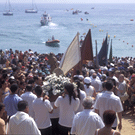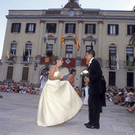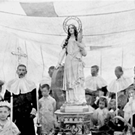
Santa Cristina maritime procession
 8 , July 2025
8 , July 2025
According to legend, townspeople from Lloret used to make a procession every year on Saint Christine's Day to celebrate High Mass at the hermitage dedicated to the saint, about two miles outside the town.
However, many of the faithful found the procession arduous as it followed rough paths and forded the Riufret, Sa Riera d'en Passapera and Sa Riera d'en Carrabana streams. Rain increased the hardship, and so in order to make the pilgrimage easier, the townspeople begged the religious authorities for permission to make part of the trip by sea, breaking the procession at Lloret beach and restarting at Santa Cristina beach. Many obstacles had to be overcome before the Holy See in Rome finally granted authorisation.
The Santa Cristina maritime procession is held on 24th July.
|

'El Ball de Plaça' (Dance in the Town Square)
 8 , July 2025
8 , July 2025
This dance, also known as the Dansa de les Almorratxes, ('Dance of the perfume jars') has been held since time immemorial and probably evolves from a former Candle Dance to mark the arrival of new churchwardens to the local hermitage. Although the music dates from the eighteenth or even nineteenth century, the dance itself is of much older, undeniably Moorish origin, as witnessed by the use of a four-spouted glass jar (known as almorratxa) of perfumed water which the male dancers offer to their partners. According to legend, at the time when the coast of Catalonia was under frequent attack from Moors and Berbers, a rich young Moor landed in Lloret and fell in love with a local Christian maiden. The young man tried in vain to woo the girl but was rejected because of the difference in religion between them.
Finally, at a dance one day, the Moorish boy appeared before the crowd dressed in his finest clothes, approached the maiden and offered her a glass jar of perfumed water. The indignant girl grabbed the jar and smashed it to the ground. It is said that the Moor returned to Africa in shame and the unhappy girl later joined a convent. Nowadays, every year on 24th and 26th July, four pairs of dancers perform the Ball de Plaça. The female dancers, chosen every year as churchwardens of Santa Cristina hermitage, wear long, elegant white dresses and the male dancers wear dark suits. The four girls arrive to the square on the arm of older male churchwardens from the hermitage and are then formally presented to the dance partner of their choice.
The dance opens with slow, ceremonial music, with the couples holding each other's right hand. Then, in re-enactment of the episode between the Moorish boy and the Christian girl, the female dancers grab the perfume jars and hurl them to the ground. If the jar breaks, it is said that the girl will marry during the following year. At the end the tempo changes and the dance finishes up with the lively 'Toquen a córrer' melody.
|

Foundation of Santa Cristina hermitage
 8 , 2025
8 , 2025
According to the legend, a young shepherd boy found a statue of Saint Christine in the place where the hermitage is now situated. The astonished boy told his story to the local priest and the townspeople, who organized a solemn procession to transport the statue to the parish church, formerly at Les Alegries.
The following day, however, the statue had inexplicably disappeared from its resting place. Robbery was out of the question since the statue was wooden and devoid of any tempting gold or silver ornamentation. Nobody could have removed the statue in daylight without being seen and at night the church was locked. The door showed no sign of forced entry.
Shortly afterwards, the statue turned up again on the same hillside by the sea where the shepherd boy had originally found it. On that day, the people of Lloret realised that the proper place of veneration for the statue of Saint Christine was right there on that beautiful hill beside the sea and a modest chapel was soon built. The chapel is now known as the Santa Cristina hermitage.
|
 Search
Search

 8 , July 2025
8 , July 2025
 8 , July 2025
8 , July 2025
 8 , 2025
8 , 2025






 Tell to a friend
Tell to a friend